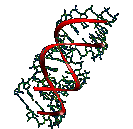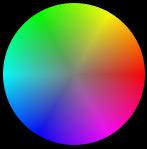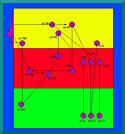




"Until now, G. had spoken only of the law of three principles. But now I saw how three passed into four and understood the necessity of this division so long as the division of force and matter exists for our immediate observation."
P. D. Ouspensky, In Search of the Miraculous

But the threefold is ideal: It does not exist here in the material world or, rather, it is made physical by fourness. Examples of this 3/4 relationship include the fourth way's carbon, oxygen, nitrogen, and then hydrogen which may be any of the previous three. More specifically, in the fourth way, the distinction between three and four is brought out as the difference between "forces" and "matters", that is, three forces and four matters. The forces are Active, Passive, and Neutralizing; the matters are Carbon, Oxygen, Nitrogen, and Hydrogen. Carbon is matter in which the active force is manifesting, Oxygen is matter manifesting the passive force, Nitrogen is matter manifesting the neutralizing force, and Hydrogen is matter taken without regard to force, or in which no force is manifesting.

[Eddington is beginning to "build a world"; that is, he is going to attempt a model of the universe.]
"We take as building material, relations and relata. The relations unite the relata: the relata are the meeting points of the relations. The one is unthinkable apart from the other. I do not think that a more general starting-point of structure can be conceived."To distinguish the relata from one another, we assign them monomarks. The monomarks consist of four numbers ultimately to be called 'co-ordinates'. But co-ordinates suggest space and geometry, and as yet there is no such thing in our scheme; hence for the present we shall regard the four identification numbers as not more than an arbitrary monomark. Why four numbers? We use four because it turns out that ultimately structure can be brought into better order that way, but we do not know why this should be so."
Sir Arthur Eddington, The Nature of the Physical World
So here we have, in the words of a 20th century physicist, the very qualitative number significance to be discussed here: three is ideal, and must pass into four to be actualized.

In his very first words in the Timaeus, Plato begins in an apparently offhand way:
Socrates: "One, two, three; but where, my dear Timaeus, is the fourth of those who were yesterday my guests and are to be my entertainers to-day?"And much of the Timaeus is concerned with the relation of three and four that we are pursuing here. Plato supports the same number qualities we've been discussing:
Plato, Timaeus
"But two things cannot be rightly put together without a third; there must be some bond of union between them."
So first we have the basic necessity of three proceeding out of two. He names these three "being", and "space", and "generation" (according to one translation I have.) After speaking of being and generation and space in the creation of the universe, the narrator of the Timaeus says:
Of these and other things of the same kind, relating to the true and waking reality of nature, we have only this dreamlike sense, and we are unable to cast off sleep and determine the truth about them.And shortly after he says:
"Thus have I concisely given the result of my thoughts; and my verdict is that being and space and generation, these three, existed in their three ways before the heaven;..."
And a little later:
"A man may sometimes set aside meditations about eternal things, and for recreation turn to consider the truths of generation, which are probable only; he will thus gain a pleasure not to be repented of, and secure for himself while he lives a wise and moderate pastime."This is full of significance, and Plato's approach is not to explain multiplicity through the "descent" of number, but rather the reverse: to approach eternal realities by "climbing up" the qualities of number. To Plato, three is the eternal realities and four is the generated world. The study of four is interesting ("a wise and moderate pastime"), but such things are only "probable"; that is the actual creations of four are but temporary and imperfect examples of the eternal three.Plato, Timaeus
And, most significantly, he says that in our sleep we cannot see the actual realities of three. We can however, consider the world generated by four, and in it see the appearance of things as representative of something higher, as a means "to cast off sleep and determine the truth".
The four that Plato is referring to are the familiar Fire, Air, Water, and Earth. In fourth way terminology, we might say that he recommends the study of the interaction of matters (Carbon, Nitrogen, Oxygen, and Hydrogen) to gain insight into the three forces (Active, Neutral, and Passive).
A final note on Plato's profound opening to the Timaeus. When Plato has Socrates say the first three, Socrates is performing an action, counting. He is not referring to things. But when he refers to four, it is "the fourth", a thing. Three actions, our forces, precede physical existence in space/time ("where is the fourth?").
Aristotle's causes map to fourth way terminology as such:


While all this may seem remote from our day-to-day lives, the idea here is that we can see this relation of the ideal three to the practical or actual four in many areas. In so doing, it is hoped, we move a little way toward the realization of the eternal verities and a little away from this "buzzing confusion" of multiplicity.


The structure of the human being is based on the instructions coded into our DNA. The programming language of DNA is quite simple: Each word or "codon" of the instruction set consists of three letters which are just different chemical bases. The purpose of this programming language is to list the order in which 20 amino acids are to be assembled to produce an enormous number of different proteins. Now with just three letters, you can specify 27 different entities (3 to the third power), more than enough to specify each of the 20 amino acids as well as a stop sequence (an end-of-this-protein-start-of-the-next-one indicator.) But in fact, it is not implemented quite this way: Instead, four chemical bases, four letters, are used.


Our view of color may provide another interesting example of the relation of three and four. In our eyes, we have certain light-receptive cells called "cones", and there are three types of cones: One type is sensitive to red wavelengths of light, another to blue, and a third to green. With these, we perceive all the colors in our colorful world.
By mixing various combinations of red, green, or blue lights we can see any color (it can be easily done on personal computers with graphics programs).
In fact, though, this three-color scheme does not appear to be the way our perception of color is actually implemented. In fact, we perceive color based on four primary colors: red, green, blue, and yellow. These colors are (conceptually) arranged as pairs of opposites, red opposite green and blue opposite yellow.


In a general way, we can speak of the "three-storied factory" of the human being as comprising an intellectual, an emotional, and a physical story. But this always remains somewhat unsatisfactory due to the multiple nature of the "physical" story. We might say we have three "psychic" functions: the intellectual, the emotional, and the moving, but for a more complete description, we speak of four basic functions: the intellectual, emotional, moving, and instinctive. As four is required to implement three, so is our instinctive functioning required to support our other three functions.


Shown above, from left to right, are Plato's "perfect solids", which he correlated to the ancient elements Fire, Air, Water, and Earth. This is a stunning visual representation of the three-Ness becoming four. The first three polygons are created of the three-sided figure, the triangle. The fourth, Earth, is created of the four-sided figure, the square.
Using the terminology of Ouspensky from the introductory quote, we could call the first three the forces, and the fourth, matter. These should correspond to the "carbon", "nitrogen", "oxygen", and "hydrogen" terminology used in In Search of the Miraculous.


Which brings us to modern physics' four fundamental forces. Modern physics is characterized by two approaches: the general relativity of Einstein is used to describe the enormous macro-scale physics of such things as black holes and the effect of gravity on light streaming across the universe; quantum physics is the remarkably successful but almost unwanted theory of what goes on at the very miniscule scale of individual photons, electrons, and so on. Why not just one theory of modern physics? The effects that relativity explains cannot be explained by quantum physics, and quantum physics cannot be explained by relativity. It seems that neither is complete.
And the most definite way this is seen is that all of quantum physics can be broken down into three fundamental forces, and all of relativity into a fourth. These numbers should be sounding familiar to the reader by this time.
Curiously, the "fourth force", that relativity requires, is gravity. The force of matter, the attraction of mass. Just for completeness, I'll mention that the names of the three forces that quantum physics encounters are called "strong", "weak", and "electro-magnetic". The "theory of everything" that some modern scientists search for is the common source of these four forces or, as we might say, unity.
So: Three forces, but a fourth is here too, and with that, we have our universe.
The four forces may also be viewed in terms of four particles:
* photons (h), carriers of the electromagnetic force;
* bosons W and Z, carriers of the weak nuclear force,
* gluons (g), carriers of the strong nuclear force;
* gravitons (G), an as yet purely theoretical particle said to be the
carrier of the gravitational force.
Perhaps more interesting though, is to look just at the "Standard Model" of particle physics, which does not include the theoretical graviton, and which has been heavily tested and experimentally confirmed. In this model, there are three forces—strong, weak, and electromagnetic, and four particles required to transmit them—g, W, Z, and photons.


I first seriously looked into food, that is, what we eat and why—how we use it—in an attempt to follow the first stages of the food diagram. A curious thing is that there are three classes of substances that are required: proteins, carbohydrates, and fats (lipids). The proteins are used structurally, carbohydrates for energy, and fats for storage. When we eat, say, a banana, the constituent parts are broken down to small particles which are then used to build up new particles which are the proteins, carbohydrates, and fats that we can directly use. Inevitable, though, in this discussion of carbohydrates, fats, and proteins, comes an addition something like this: "these, and the necessary vitamins and minerals, give us all we need..etc.". So what are these "vitamins and minerals? "Minerals" seems to have an obvious association with what this fourth thing often is,whether it be called the element Earth or the force gravity—the practical earth-bound ground in which the three perform. But what are these 'vitamins"?
One of the reasons I write these essays is they force me to learn more, and in this case I have to look up vitamins. Here is the first paragraph under vitamin in the Encyclopedia Britannica I have access to:
vitamin, any of various organic compounds that are essential in minute quantities in the diet of most animals. Vitamins act especially as coenzymes and precursors of coenzymes in the regulation of metabolic processes. Unlike the macronutrients (proteins, carbohydrates, and fats), they do not provide energy or serve as building units.
Again we have this element of making possible the other three, in this case, by assisting in their use.

I sat here writing this on a chair with four legs. Three legs are sufficient to support me on a plane, but in practice that doesn't work very well as I shift around, lean back and so on. But four works in practice. You may think all this is arbitrary and unimportant, or superstitious. But it is not that the numbers, say "3" and "4", have some sort of magic to them. It is rather that these are the symbols we apply to very fundamental principles, really to some of the very principles of world creation. Principles we can see manifest in everyday life, in everything.

Pyramid image at top: Guardian's Egypt - Copyright © 1995-2001 Andrew Bayuk All Rights Reserved
All pages © Copyright John Raithel